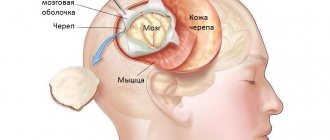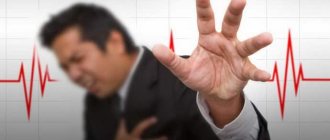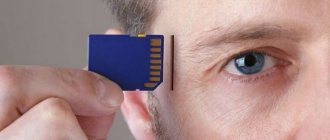Hysteria (hysterical neurosis) is a mental disorder manifested in the form of affective, sensitive, motor and autonomic disorders and associated with the patient’s desire to attract attention.
Hysteria is more common in women than in men
Hysterical disorders are more often observed in persons with a labile psyche, emotionally unbalanced, and with increased impressionability, suggestibility and narcissistic qualities. Any change in the situation can cause a violent reaction in them. In addition, such people often have a desire to attract the attention of others by any means - with the aim of subsequently manipulating them.
Hysteria is often observed in children from disadvantaged families. In women, this mental pathology occurs several times more often than in men. In the overall structure of the incidence of neuroses, hysteria accounts for approximately 30%. The following features are distinguished in the character of patients suffering from hysteria:
- excessive sociability;
- self-dramatization, theatricality, demonstrative actions;
- egocentrism;
- the desire to focus on one’s personality;
- desire for leadership in the family and (or) team;
- the desire to manipulate people;
- pronounced fantasizing up to deceit;
- infantilism;
- heightened self-esteem;
- suggestibility.
Unlike psychopathy, the symptoms of hysteria clearly manifest themselves in the obligatory presence of other people, that is, they are characterized by obvious demonstrativeness.
Causes and risk factors
The main reason for the formation of hysterical attacks is the hysterical mentality. This condition can also develop in people with excitable and schizoid personality disorders.
According to S. Freud, the causes of mental disorders in absolutely all patients with hysterical neurosis lie in childhood. These may be experienced mental trauma, as well as sexual complexes.
In most cases, the causes of hysteria lie in childhood
The trigger factor for the appearance of hysteria is any sudden stressful situation (death of a loved one, conflict in the family or team, threat to life, breakup with a loved one). The hysteria that arises against their background allows patients not only to throw out their emotions, but also to derive certain benefits for themselves, for example, to receive the participation and sympathy of others. This behavior is then reinforced.
Patients without illness
According to the professor, contrary to popular belief, such a disease as “hysteria” simply does not exist. There are hysterics and hysterics, people with a hysterical type of character and with hysterical reactions. The first to deal with are psychiatrists, psychotherapists, judges and registry office workers who dissolve a marriage. The second are theater directors and producers. Nobody deals with the third, because only the dead person does not have hysterical reactions; we are all capable of demonstrating them under certain conditions. So what happens, you ask, psychiatrists have work, but there is no disease?! Exactly. Several years ago the term “hysterical neurosis” was still in use, but today it has been replaced by the florid formulation of “manifestations of a neurotic level.” The fact is that, no matter how vividly hysteria is expressed - and it can manifest itself very vividly - it is only a symptom of a developing mental illness (most often schizophrenia or some types of psychosis). So this word must be used with caution.
Symptoms
Unlike psychopathy, the symptoms of hysteria clearly manifest themselves in the obligatory presence of other people, that is, they are characterized by obvious demonstrativeness. All signs of hysteria arise and end suddenly. They are not associated with any organic changes.
The clinical picture of hysteria includes motor disorders:
- impaired coordination of movements;
- hand tremors;
- aphonia (loss of voice);
- hyperkinesis (muscle tics);
- convulsions.
During the examination of the patient by a doctor, the manifestations of hysterical neurosis intensify.
With hysteria, patients may experience neurological disorders (unsteady gait, blindness, lack of speech, deafness).
Manifestations of hysteria have characteristic features that distinguish them from symptoms of somatic diseases:
- Hysterical aphonia is characterized by the absence of a voice, but the sonority of coughing is preserved, since with hysterical paralysis, patients do not develop atrophy of muscle tissue;
- In an effort to attract attention, patients feign fainting, respiratory distress, rush about, and wring their hands. But if, at the moment of a seizure, their attention is switched to other objects, the manifestations of hysteria disappear or their severity sharply decreases.
Hysteria may also be accompanied by sensory disturbances. They manifest themselves either by increased sensitivity (hyperesthesia), or, conversely, by its decrease or absence. Patients clearly indicate the location of areas with impaired sensitivity. Sensory disturbances during hysteria also include areas of pain in any part of the body.
Hysteria may be accompanied by hyperesthesia - increased sensitivity of certain parts of the body
Often with hysteria, one- or two-sided blindness or deafness is observed. Some patients complain of a decrease in the field of vision or incorrect perception of color, but their ability to adequately navigate the surrounding space is not impaired. Deafness in most cases is combined with impaired sensitivity of the skin of the auricle.
The vegetative manifestations of hysteria are very diverse. These include:
- nausea and vomiting;
- labored breathing;
- pain in the heart or other internal organs;
- refusal to eat due to false spasm of the esophagus;
- dizziness and headache;
- skin itching.
Another manifestation of hysteria is theatrical seizures. Wanting to attract attention or achieve fulfillment of his demands, the patient bends in an arc and “correctly” falls, trying to do this safely for himself. Then he begins to hit his head on the floor, swing his limbs, cry bitterly or laugh loudly, showing with all his appearance that he is suffering terrible suffering. During a hysterical attack, the patient retains the reaction of the pupils, consciousness is not lost, the face is pale or red. If the patient is slapped in the face or poured cold water on him, the seizure stops. These signs make it possible to distinguish a hysterical seizure from an epileptic one.
Talents and fans
And yet it cannot be said that people of the hysterical type do all this consciously and thoughtfully. They are not aware of much in their behavior and are pushing it out of consciousness, Ostroglazov believes. Often such a person, realizing that in society it is customary to condemn boasting and self-exaggeration, strives (sometimes semi-consciously) to dress up in the clothes of shyness, modesty, painful introspection with self-accusation. Which is only a cover for his hysterical desire to please, to attract attention. Like any infantile person, a hysteric is capable of sincerely convincing himself that some of his actions are extremely noble, even if in fact this is far from the case. Despite all his negative traits, such a person very often finds his calling in the arts - poetry, painting, acting, applied art. And in this field he can talentedly serve society with his vividly sensual creativity. Some experts still believe that you can become a great artist only by having a pronounced hysterical type of character. And what kind of lovers do they make? How many men are ready to do any kind of madness for the sake of bright, extravagant hysterics, without whom their life would be pale and boring! Unless, of course, such “fun” got to the liver. In this case, you need to either put up with the characteristics of your life partner or get a divorce. There is no third. After all, yesterday's hysterics, alas, do not happen.
Treatment
The main method of treating hysteria is psychotherapy. It allows you to establish the true cause of hysterical neurosis and teach the patient to adequately respond to life’s difficulties.
The main treatment for hysteria is psychotherapy
Drug therapy for hysteria is carried out:
- tranquilizers;
- sedative herbal medicines;
- sleeping pills (for insomnia);
- general strengthening agents.
Meaning of the word hysteria
The name “hysteria” (hysteria, hysteriasis) comes from the Greek word ύστερα - uterus. This etymological meaning of the name of nervous disease finds its explanation in the previous erroneous view that it is associated with the uterus, with the female genital organs and is characteristic only of the female sex. Nowadays, even among doctors, there is still sometimes a tendency to see the essence of I. in a nervous disorder that has its source in the sexual sphere. But a strictly scientific study of hysterical patients forces us to reject such a view as completely inapplicable to the majority of them. Of no small importance here is the fact that both young children and men suffer from hysteria, the latter not as an exception, but in the amount of 6-10% or even more (in relation to the total number of hysterical patients). Still, the vast majority of them are women, both girls and married and widows, mainly in their 2nd, 3rd, and 4th decades. In many cases, I. is undoubtedly innate and inherent in the subject throughout his life. Moreover, very often over the course of many years it can be revealed not so much by painful attacks, but by certain features of character and well-being, so that the subject, being undoubtedly hysterical, at the same time should not be considered sick in the exact sense of the word. At times, this hysteria can be manifested by various attacks. The latter sometimes go away on their own now, or succumb to the calming influence of a glass of cold water, or do not appear again when the subject tries to suppress them by exertion of will. In other cases, the manifestations of the same disease are so severe that those possessed by it become the most unfortunate creatures, a burden to themselves and others, and almost all functions of the central nervous system, not excluding the mental sphere, can be affected simultaneously or sequentially. Sometimes the course of the disease is such that in a short time a wide variety of symptoms replace each other - seizures, hallucinations, paralysis, blindness, contractures, etc.; sometimes I. for many years is detected by only one symptom that stubbornly resists medical intervention. Post-mortem examination of subjects who suffered from I. does not reveal any microscopic, much less gross changes in the structure or blood circulation in their nervous system. Combinations of symptoms in I. in most cases are not at all similar to those observed during inflammatory and other painful processes in one or another part of the brain or spinal cord or peripheral nerves. Moreover, these symptoms, sometimes appearing suddenly, in the midst of apparent complete health, lasting in some cases for a very short time, in others - days, weeks, months and even years, then just as suddenly they can disappear following the impact on the patient’s psyche. Mental influences and imagination also play a huge role in the sense of the moment that causes certain symptoms of I. Finally, the picture of I. also includes various forms of insanity, which differ from other, non-hysterical psychoses in their characteristic features. In view of all that has been said, I. occupies a completely unique position among nervous diseases, and it is very difficult to give an exact definition of I. It belongs to the so-called. general functional neuroses, i.e., such suffering that is not caused by local material damage to a certain part of the nervous system, but depends on a general violation of its functions. At the same time, due to the enormous importance that imagination has in I., and according to the character traits of hysterical subjects, it is necessary to look for the main source of the disease in a peculiar deviation from the norm of that organ that we consider the substrate of mental activity, namely the cerebral cortex; but this deviation is so subtle that it does not necessarily lead to mental disorder and is compatible with complete preservation of mental abilities.
Before describing individual symptoms of hysteria, it is necessary to dwell on the general characteristics of the mental characteristics characteristic of these patients. They are determined primarily by the excessive predominance of the sensual, emotional side of spiritual life over the intellectual; This trait generally distinguishes the female sex, and with I. it seems to become aggravated, hypertrophied. Therefore, the reason for the predominant predisposition of women to I. in comparison with men must be sought in the distinctive features of the normal mental organization of the former. Due to the excessive development of the emotional sphere, I. is characterized by increased impressionability and instability of mood, which is easily subject to fluctuations without any apparent reason. Then comes a quick, unmotivated change in drives, leading to painful moodiness. The ability of imagination is also increased, and thanks to this, ideas that arise by chance acquire greater vividness, easily lead to affects and upset the balance of nervous functions. The inhibitory ability, which characterizes the highest mental organization, is weakened in I.: fleeting impulses become uncontrollable, and the external reaction to internal mental processes occurs faster and stronger. Laughter and crying easily become convulsive and cannot be stopped. These basic mental characteristics of hysterical subjects are in many cases, but not always, accompanied by ethical defects: constant dissatisfaction with others, extreme quarrelsomeness, the desire to focus everyone's attention on oneself, eccentric behavior, pretense, deceit, heartlessness; at the same time, intelligence, logical thinking ability and memory can be well developed. In educated subjects who have received a good upbringing, the listed moral qualities, in contrast with their intellectual development, are especially striking; but they are often found among simple, poorly educated and undeveloped women, appearing only then in less sophisticated forms. One must not just forget that many hysterical individuals are completely free from moral defects, which in any case constitute a product of the disease and therefore require condescension and apology from those around them. On the other hand, often the disdainful attitude of others towards the complaints and suffering of hysterical people due to the false view that it is all just imagination and that these patients can recover if they only want to, gives rise to their embitterment and partly to the deliberate intensification of painful symptoms. As already mentioned, these symptoms may sometimes be absent during the entire course of the illness, and the latter then comes down entirely to the possession of a hysterical character. However, where this character is sharply expressed, one of the specially described below hysterical defeats usually appears temporarily. But vice versa - the type of hysterical character outlined above can be barely outlined, and the subject is occasionally subjected to these manifestations. Turning to the description of the latter, we will begin with hysterical psychoses.
Mental disorders of hysterics can be divided into three categories. Firstly, on the basis of I. an ordinary form of psychosis can develop, for example. melancholy or mania, and proceed as is generally characteristic of this form, only with some features determined by this hysterical soil. Secondly, hysterical insanity is revealed in the form of a chronic, protracted illness that occurs under the guise of primary, resonating or moral insanity. Those hysterics are especially prone to the latter, in whose character the moral defects noted above are sharply expressed, and their insanity represents only a further development of their inherent mental properties, a kind of hypertrophy of their character. These patients, due to their inclination to lies, deception, false denunciations, and then to impulsive actions, often give rise to criminal trials and, due to their eccentricity, love of scandals and the absence of any ethical principles, are extremely inconvenient in freedom. The course of these chronic forms of hysterical insanity differs from the corresponding forms of non-hysterical origin mainly by the greater preservation of mental abilities, and in addition, by periodic exacerbations and weakening of pathological phenomena; finally, the significant role played by the erotic element, and a perversion of sexual desire is often observed. The third category of hysterical psychoses embraces cases of short-term insanity, appearing episodically, lasting from several hours to several days or weeks. These attacks occur mainly after some kind of moral shock and are often combined with attacks of convulsions. The usual manifestation of these attacks of hysterical insanity is clouding of consciousness, frightening or delightful hallucinations and delirium, in which those real events that currently disturbed the mental balance of the patient often play a large role. Especially often during these attacks there are states of ecstasy with religious and erotic delirium, or states of intense fear of imaginary monsters, or frenzy with demonomaniacal delirium; the latter form played a large role in the hysterical epidemics observed so often in the Middle Ages. A distinctive feature of all these transient hysterical psychoses is that, despite the confusion of consciousness, patients at this time are still in most cases accessible to mental influences, through which it is possible to calm them down, stop or modify the course of the attack. A completely special group of mental changes consists of those changes in consciousness during I. that correspond to the various stages of hypnotic sleep. They can be induced artificially (see Hypnotism), but they can also appear spontaneously, both in connection with convulsive seizures and independently of them. These include attacks of lethargy, catalepsy and somnambulism, the features of which are described in the above-mentioned description of hypnotic phenomena. Each of these conditions in I. can be observed for a long time, usually several hours or days. Closely related to somnambulism are the “split personality” states characteristic of I., which are very interesting from a psychological point of view. They lie in the fact that patients periodically, over the course of several weeks or months, discover completely different character traits, habits, ways of expression, in a word, a completely different “personality” than the one that is characteristic of them in a normal state; and most importantly, during the period of this personality change, they do not remember anything that relates to their normal state of consciousness, for example. - they don’t recognize old acquaintances. When the normal state of consciousness is restored, a complete absence of memory of everything that is abnormal is noticed. When the latter then returns, the memory for all the time corresponding to normal periods again disappears, but the memory of what belongs to the previous abnormal periods is resurrected, etc. Thus, two closed successive series of mental processes are established, the consciousness of which alternates each other; the mental personality, as it were, splits into two “ I ”, each of which has its own consciousness independent of the other. Observations of this kind are generally rare and were mainly described by French doctors, who called these two types of consciousness in the same person “condition premi è re” and “seconde”. Despite their rarity, they rightly excite great interest because of their importance for the theory of consciousness and have recently played an important role in the French psychological literature.
I.'s symptoms from the nervous system are usually grouped according to the various functions of the latter. In the sphere of sensitivity, the most common phenomena in I. belong to the so-called. anesthesia, i.e. loss or weakening of sensitivity. They sometimes spread to the entire body, sometimes only to certain areas, very often to one half of the body. In this case, usually on one half of the body, not only the tactile and pain sensitivity of the skin is lost or weakened, but also the functions of other sense organs - vision, hearing, smell and taste. This insensitivity to pain, which constitutes an extremely common symptom of I., was repeatedly found in the notorious “witches” who so often appeared before the Inquisition in the Middle Ages, and was then considered evidence of a connection with the devil (stigmata diaboli). A distinctive feature of hysterical anesthesia is that they can appear suddenly and disappear just as suddenly. By the way, under the influence of the application of metals or a magnet to insensitive areas, anesthesia disappears here and at the same time appears on the opposite symmetrical area. This phenomenon, known as transfera (transfer of sensitivity), was discovered by Charcot when he began to test the teachings of Dr. Burke about the effect of the application of metals on diseases. The opposite of anesthesia, also often observed in hysterics, is increased sensitivity (hyperesthesia). Often on the body of hysterical people there are separate points or areas, the touch or pressure of which causes seizures (the so-called zones hyst érogènes); Pressure on the ovarian area especially often has this effect. Further, common sensitivity disorders in I. include neuralgic pain in various parts of the body, mainly headaches and migraines.
In the motor sphere, the main role in I. is played by convulsions, mainly in the form of seizures of varying strength and duration. One can rightly speak of a special convulsiveness characteristic of hysterical people in general, thanks to which in them any physiological movement easily takes on pathological proportions. Everyone knows this name. hysterical laughter and crying, immediate reinforcement and continuation of normal. Convulsive compression of the esophagus is very common, in which the patient feels as if a ball is rising from the bottom up and rolling under the throat (the so-called globus hystericus). Similar convulsive compression occurs in other internal organs (in the respiratory tract, bladder, genital area, etc.), causing corresponding dysfunctions - shortness of breath, vomiting, etc. Fortunately, convulsive compression of the glottis is rare; such a spasm, if it persists for a slightly longer period of time, directly threatens life and has sometimes been the cause of death in I. Further, the skeletal muscles are subject to spasms in a wide variety of combinations and forms. Sometimes these convulsions occur in the form of a local symptom, without any general reaction of the body and not particularly aggravating the patients. Sometimes they take on such a formidable character that they plunge those around them into horror, and, moreover, accompanied by clouding of consciousness, they constitute the center of gravity of the entire illness. These grand mal seizures are called hysteroepileptic, or grande hysté rie. They were carefully studied by Charcot in French women, who seem to be more predisposed to them than other races, although similar attacks are observed everywhere, as well as in men and children. In their classical form, major I.'s seizures represent a well-known regularity of the course and allow, according to Charcot, to distinguish four phases. The attack begins suddenly; it is rarely preceded by some subjective phenomena by which patients feel its approach. The first phase consists of convulsions that are very similar to epileptic ones, which is why they speak of hysteroepilepsia in these cases. Then comes a period in which patients bend their torso in the most bizarre way, often in the form of an arc, jump high out of bed, make movements similar to a greeting, randomly wave their arms and legs and at the same time emit wild screams, sometimes completely unlike the human voice. In this phase, muscle tension reaches an incredible degree, and sometimes six nurses are not able to hold the patient. This period of convulsions was called “clownism”, or “big movements”. This is followed by the phase of “passionate poses”, in which the figure and face of the patients express ecstasy, horror, despair, and other affective states. Finally, even after the convulsive phenomena have subsided, delirium with clouding of consciousness and deceptions of the senses is observed for some time, and only from this fourth phase do patients return to their normal state, retaining a vague memory of the seizure. Its duration can reach up to several hours, and sometimes a whole series of attacks is observed, directly adjacent to each other for several days. It should be noted that such classic attacks are generally rare. In most cases, hysterical attacks are less typical, consisting of fragments of one or another phase. Very often, instead of such a stormy picture, there is only a general trembling with lightheadedness and dizziness, or a condition similar to an attack of angina pectoris, or attacks of convulsive hiccups, yawning, coughing, palpitations, etc., or a combination of such convulsive phenomena, with infinite variety. Another category of hysterical disorders in the motor sphere consists of contractures (limbs) and paralysis. The former may constitute a passing symptom involved in a seizure, but often appear in isolation and persist for a long time, sometimes for many years. Hysterical paralysis comes in all possible combinations and degrees. Sometimes they appear suddenly, with phenomena reminiscent of a brain stroke, and like the latter, they affect half the body. Sometimes, on the contrary, they develop gradually, starting with mild motor weakness, and in their course and localization resemble the disease patterns produced by chronic lesions of the spinal cord or brain. Sometimes they occupy only one limb or muscle group. They can also be a short-lived symptom or last several months or even years.
In comparison with the listed symptoms in the sensory and motor spheres, the combinations of which constitute the usual form of I., disorders of other functions are rare, and we will only note the main ones. Speech can be disrupted either in the form of loss of sound ability, so that only whispered speech is possible, or in the form of complete muteness (so-called mutism). Vasomotor disorders lead to swelling of the skin on the limbs or face, or to the appearance of blood (so-called stigmatization) on various parts of the body, or, finally, to hemoptysis, which sometimes makes a hysterical patient mistaken for a consumptive one. Further, abnormalities in metabolism are observed, an excessive increase in body temperature to 43° C. or more without the presence of a real fever, abnormalities in the secretion of sweat, urine, and many others. etc.
As for the course of the disease , depending on the participation of one or another of the listed painful phenomena, the difference between individual cases of mild and severe I. is extremely great. Fortunately, serious cases are in the minority. In practice, such hysterics predominate, who predominantly suffer from subjective symptoms, exhibit character anomalies that are still within the limits of mental health, and from time to time undergo hysterical attacks; in this case, long intervals are observed, sometimes spanning several years, during which the disease has very little effect. In men, I. more often occurs in a severe form than in a mild one. I. almost never poses a danger to life. Except for rare cases when death occurs as a result of convulsive compression of the glottis, it is in exceptional cases caused by exhaustion of the body due to persistent loss of appetite, sometimes observed in severe cases of I. Hope for a cure should never be lost, even if some hysterical symptoms have existed for many years, since they can always disappear without a trace.
Among the causes of I., heredity is in the foreground in the sense that being descended from parents, especially from a mother, who suffered from I. or other nervous or mental illnesses, predisposes to this disease, which in this case can appear without any apparent reason, under the most favorable conditions of upbringing and life. In any case, the upbringing given to children by a hysterical mother can further aggravate the influence of hereditary predisposition, to the extent that an example of a hysterical character through unconscious imitation can contribute to the development of similar mental properties in children. Quite often, I. is one of the manifestations of degeneration, and it is in these cases that it easily takes the form of chronic hysterical insanity with a defect in moral feelings. However, there is no doubt that I. can also occur in subjects in whose family the conditions of neuro- or psychopathic heredity are completely absent, and here the main reasons are mental shocks. A special role among the latter is played by those associated with the affects of disappointment, disappointed hopes, unhappy love, etc., then fear due to physical shock to the body, for example. train wrecks. Although the upper classes of society predominate among hysterical patients, that is, educated subjects whose mental life reaches a more complex and subtle development, the simple class is also susceptible to this disease, not excluding the illiterate peasant population and the lower ranks. Then, irregularities in sexual life are of great importance, mainly excessive sexual activity in men, increased sexual arousal without satisfaction in both sexes, as well as various techniques used during sexual intercourse to eliminate the possibility of conception. Physical exhaustion, anemia, and malnutrition contribute to the detection of I. in persons predisposed to it, but in themselves cannot be considered sufficient causes of this disease. At the very least, many hysterical people regarding general nutrition leave nothing to be desired, and it often falls after the appearance of nervous disorders, depending on them. In the same way, the suffering of the uterus and ovaries, even when they are present in hysterical women, is not always the cause of their nervous illness.
The treatment of hysterical patients differs in many ways from the treatment of others, even those suffering from the nervous system. Here, less than anywhere else, one can be guided by the principle that such and such a painful symptom is inferior to such and such a medicine or therapeutic method. The main thing that must be taken into account here is the enormous suggestibility of hysterical patients, the large role that their imagination plays, and their increased subordination to psychic influences. The latter often serve as an impetus for the appearance of one or another symptom, and its disappearance is determined in the same way. Therefore, the first condition for the successful treatment of hysterical patients is the ability of the doctor to gain their trust and have moral influence on them. Often the best doctor turns out to be powerless to cure a given hysterical woman, because she feels an unmotivated, but irresistible antipathy towards him. As for the technical side of treatment, there is no need to expand on this here. It is enough to point out that all means generally used for nervous diseases are used against I., with a predominance of those aimed at general strengthening of the nervous system, such as hydropathic techniques, various types of electrotherapy, massage, mineral waters, etc. To combat individual symptoms of And. hypnotic treatment is also important. In cases of hysterical psychosis, placement in an institution for the mentally ill may naturally be required. But even in the absence of insanity, in severe and persistent cases of I. it is often very important to remove the patient from the environment in which the disease appeared and organize treatment in a special hospital (for nervous patients), away from relatives, who for the most part do not know how to treat hysterical patients correctly. Due to the increased suggestibility of hysterical people and the decisive importance that “faith” in this or that remedy has for them, they constitute a large contingent of cases of “miraculous” healing, depending on the area, which for some reason enjoys an aura of holiness and miraculous power (for example, Lourdes ), and through the psychic influence of persons who, for one reason or another, have such a reputation.
Literature. In addition to the large chapters occupied by I. in manuals on nervous and mental illnesses, many monographs are devoted to it, partly those in which it is considered from some special point of view. Detailed bibliographic instructions (until 1877) are available in Jolly’s monograph and in Ziemsen’s manual of private pathology and therapy (XII volume). Briquet's outdated work “T raité clinique et thérapeutique de l'hysté rie” (P., 1859) is considered a classic work. Of the newest works that deserve special attention: Legrand du Saulle, “Les hyst ériques, état physique et mental, actes insolites, dé lictueux et criminels” (P., 1883); Charcot, “Le çons sur les maladies du systè me nerveux” (P., 1883-1887); Weir-Mitchell, “Lectures on diseases of the nervous system, especially in women” (2nd ed. London, 1881); Pitres, “Le çons cliniques sur l'hysté rie et l'hypnotisme” (P., 1891); Pierre Janet, “Etat mental des hyst é riques, les stigmates mentaux” (P., 1893); L ö wenfeld, “Pathologie und Therapie der Neurasthenie und Hysterie” (Wiesbaden, 1894).
P. Rosenbach.
Prevention
Prevention of the development of hysteria is based on measures aimed at preventing disorders of nervous processes and the psyche, increasing the resistance of the central nervous system to stress. It is especially important to carry out these activities in relation to children, since a hysterical personality begins to form at an early age.
It is necessary to limit the child’s fantasies and imagination to reasonable limits, involve him in communicating with peers and playing sports, avoid overprotection, and not indulge in attempts to attract attention with hysterics. Raising a child should take place in a calm environment, which will create the prerequisites for the formation of a full-fledged personality.
Video from YouTube on the topic of the article:
Test yourself
Despite some differences, hysterics reveal many similarities. Such people are characterized by: >> an emotionally charged desire for originality (eccentricity in clothing, expressive forms of behavior and “theatrical” actions); >> demand for recognition from others; >> constant feeling of internal tension; >> hypersensitivity to interpersonal relationships; >> tendency to increased suggestibility; >> a penchant for invention, imitation and various adventures; >> hypochondria (a tendency to search for unknown, mysterious diseases). PERSONAL OPINION Andrey Chernyshev, our first reader: It is believed that all actors are characterized by increased emotionality. This is due to the great psychological stress due to the need to transform from role to role. When I feel nervous tension, I always remember the wonderful phrase that Georgy Vitsin said: “When leaving the stage, do not forget to get out of character.” It helps me control my emotions.











